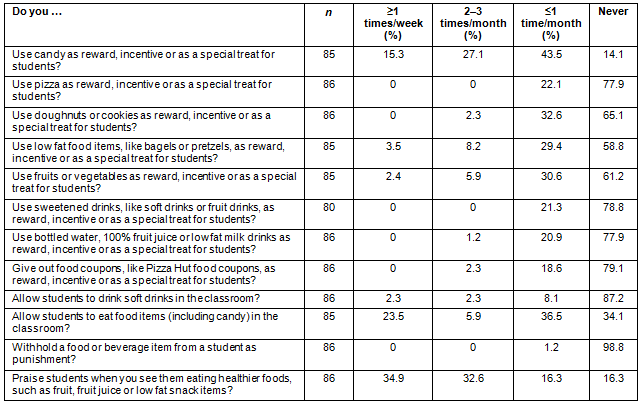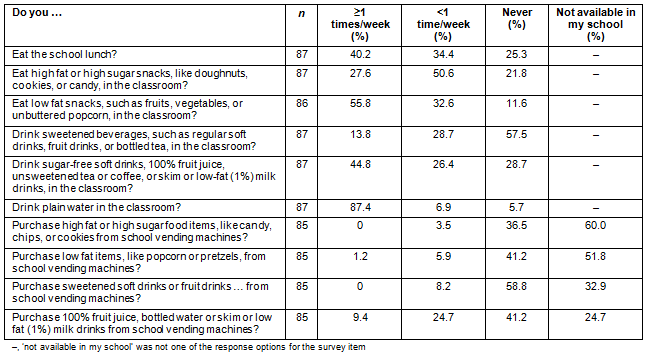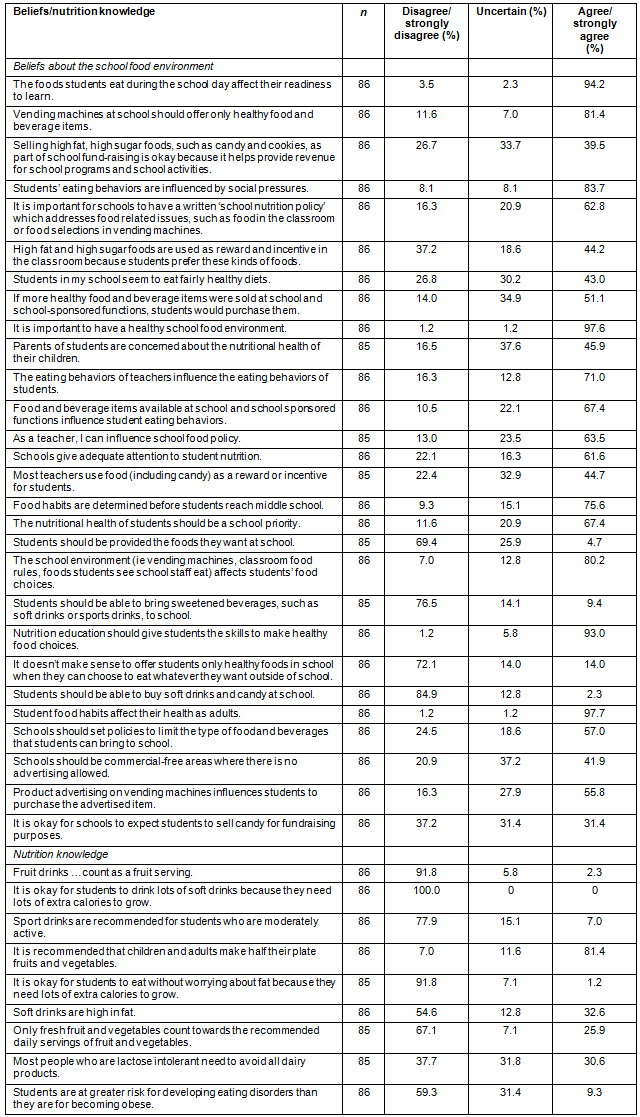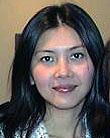full article:
Childhood overweight and obesity is a serious public health problem that disproportionately affects rural populations in the USA. A recent analysis using nationally representative data found that 35.4% of rural children aged 2-19 years were overweight (body mass index values at or above the 85th percentile for age and sex) compared with 29.3% of urban youth1. Likewise, the rates of obesity (body mass index values at or above the 95th percentile) were higher for rural children than for their urban counterparts (18.6% vs 15.1%). Helping children to establish healthy eating behaviors is an essential component of childhood obesity prevention2, and may be especially important in rural areas.
Schools have a key role to play in the development of healthy eating behaviors among children both because of their ability to reach children and the great amount of time that children spend at school each day2. Research has shown that factors such as the types of food available in school cafeterias and school policies that permit or deny access to competitive foods and beverages (those that are not part of the National School Lunch Program or School Breakfast Program) are influential in shaping children's eating behaviors3-8. In recent years, significant efforts have been made to improve school food environments, including passage of the Child Nutrition and WIC Reauthorization Act of 20049 and the Healthy, Hunger-Free Kids Act of 201010. However, the primary focus of efforts to date has been on ensuring that foods and beverages available within schools are nutritious, with little attention given to other important aspects of the school food environment, including teachers' classroom food practices and role modeling behaviors.
The idea that teachers' practices and behaviors influence children's eating habits is supported by ecological models of obesity11,12 and social cognitive theory13. These theories posit that the social environment plays a role in shaping behavior, in part by providing models for behavior that is normative or acceptable. Within the school setting, teachers are important role models for children and can influence children's eating behaviors through their own actions and behaviors12. In addition, teachers are authority figures in the classroom and have ample opportunity to share their knowledge and beliefs about food with students13,14. However, little is known about teachers' behaviors, practices, and beliefs relevant to food.
To the authors' knowledge, only two studies have examined the food-related behaviors and beliefs of teachers in the USA. One of these studies was conducted in an urban setting14, and the other on an American Indian reservation15. Both studies found that the use of low-nutrient foods, especially candy, as rewards or incentives for students was a common practice among teachers, and that many teachers did not role model healthy eating behaviors at school. For example, teachers often reported purchasing or consuming sweetened beverages at school. However, these studies also found that most teachers supported limiting students' access to candy and soft drinks and believed that food advertising should not be permitted in schools.
Given that rural children experience high rates of obesity, it is important to develop a more complete understanding of the rural school food environment, including teachers' behaviors and beliefs relevant to food. Thus, the objective for the present study was to examine the classroom food practices, personal eating behaviors at school, beliefs about the school food environment, and nutrition knowledge of rural elementary and middle school teachers.
Participants and setting
The participants in this study were elementary and middle school teachers (grades K-8, students usually aged 5-14 years) from eight rural school districts in Oregon that were involved in SNACZ, an intervention trial to improve the nutritional quality of children's snack choices by creating school and community environments that support healthy snacking. The eight school districts were located in small communities with fewer than 2000 residents each in Union and Wallowa counties, two sparsely populated agricultural counties in north-eastern Oregon. All elementary and middle school teachers who were employed in these school districts were eligible to participate in the study, a total of 102 teachers.
Study instrument
The study instrument was a modified version of the Teens Eating for Energy and Nutrition at School (TEENS) teaching staff survey14. The TEENS teaching staff survey is a 100-item closed-ended questionnaire with confirmed face validity that was designed to assess middle school teachers' personal health and eating habits, classroom food practices, beliefs about the school food environment, and nutrition knowledge. For the present study, items pertaining to teachers' personal health and overall eating habits (ie items not specific to the school setting) were omitted. Items pertaining to teacher demographics and years of teaching experience were also omitted to enhance confidentiality and maximize teacher participation in the survey. Five items about teacher eating behavior in the classroom ('How often do you: (a) eat high fat or high sugar snacks, like doughnuts, cookies, or candy, in the classroom?; (b) eat low fat snacks, such as fruits, vegetables, or unbuttered popcorn, in the classroom?; (c) drink sweetened beverages, such as regular soft drinks, fruit drinks, or bottled tea, in the classroom?; (d) drink sugar-free soft drinks, 100% fruit juice, unsweetened tea or coffee, or skim or low fat (1%) milk drinks in the classroom?; and (e) drink plain water in the classroom?) and two items concerning teachers' opinions about school policy ('Students should be allowed to bring sweetened beverages, such as soft drinks or sports drinks, to school'; 'Schools should set policies to limit the type of foods and beverages that students may bring to school') were developed based on findings from previous focus groups with a subset of teachers from the same schools16 and were added to the survey.
To ensure the additional items had acceptable face validity, they were reviewed by four experts in the areas of school nutrition and elementary education. Suggestions from the experts, such as wording changes, were incorporated into the final survey. In total, there were 59 items in the modified survey, organized into four sections: (1) teachers' classroom food practices, (2) teachers' eating behaviors at school, (3) teachers' beliefs about the school food environment, and (4) teachers' nutrition knowledge. Likert scale response categories for items pertaining to the frequency of teachers' classroom food practices were '2 or more times a day', '1 time a day', '1-3 times per week', '2-3 times per month', '1 time or less per month', and 'never'. Response categories for items pertaining to the frequency of teachers' eating behaviors at school were '4 or more times per week', '1-3 times per week', '2-3 times per month', '1 time or less per month', and 'never', with an additional response category, 'not available at my school', for four items pertaining to vending machine purchases. Response categories for items concerning teachers' beliefs about the school food environment and teachers' nutrition knowledge were 'strongly agree', 'agree', 'uncertain', 'disagree', and 'strongly disagree'.
Procedures
In November 2012, all teachers in the participating schools were sent an email invitation to complete a baseline survey using Survey Monkey, a web-based survey tool (Survey Monkey; http://www.surveymonkey.com). The email explained that participation was voluntary, that responses would be anonymous, and that completing the survey indicated informed consent. A $5 gift certificate to a local food store was offered as an incentive for participation. A reminder email was sent 13 days after the initial invitation, and the survey was closed 6 days after the reminder. The electronic survey was set up so that entered data could not be linked to individual respondents. At the request of their school principal, teachers at one school were provided with a paper copy of the survey in addition to the electronic survey and were given the option of using either format. Eight teachers chose to use the paper version. The completed paper surveys were placed in an unmarked envelope and collected by a research assistant, who entered the data into Survey Monkey.
Data analysis
The data showed limited frequency within some response categories; therefore, these categories were collapsed. For items pertaining to teachers' classroom food practices, the categories '2 or more times a day', '1 time a day', and '1-3 times per week' were collapsed into a single category, '1 or more times per week'. Similarly, for items regarding teachers' eating habits at school, the categories '4 or more times per week' and '1-3 times per week' were collapsed into '1 or more times per week', and the categories '2-3 times per month' and '1 or less per month' were collapsed into 'less than 1 time per week'. Finally, for items pertaining to teachers' beliefs about the school food environment and teachers' nutrition knowledge, the categories 'agree' and 'strongly agree' were collapsed, and 'disagree' and 'strongly disagree' were collapsed. Frequencies were then calculated for each response category using Statistical Analysis Software v9.4 (SAS; http://www.sas.com).
Ethics approval
This study was approved by the Oregon Health and Science University Institutional Review Board, approval number 8033.
Eighty-seven teachers completed the survey, an overall response rate of 85%. Response rates by school district ranged from 64% to 100%.
Table 1 presents the frequencies of teachers' classroom food practices. Most teachers (85.9%) used candy as a reward/incentive for students. Other foods used by at least one-third teachers included low fat items, such as bagels or pretzels (41.1%), fruits and vegetables (38.9%), and doughnuts or cookies (34.9%). For the most part, teachers indicated that the use of foods as rewards/incentives occurred one or fewer times per month; however, more than 42% of teachers reported using candy at least two to three times per month. In addition, nearly 66% of teachers allowed students to eat in the classroom and almost 13% permitted students to drink soft drinks in the classroom, while about 84% reported that they praised students when they saw them eating healthier snacks or beverages.
Table 2 shows the results pertaining to teachers' eating behaviors at school. Most teachers reported drinking plain water (94.3%) and eating low fat snacks (88.4%) in the classroom. However, a substantial percentage also reported consuming high fat or high sugar snacks (78.2%) and sweetened beverages (42.5%) in the classroom, although the majority of teachers reporting these behaviors indicated that the behavior occurred less than once per week. More than half of the teachers reported that high fat or high sugar food items were not available in vending machines at their school, but that sweetened beverages were available. Purchases of sweetened beverages and high fat or high sugar foods from school vending machines were uncommon.
Table 3 presents frequencies of teachers' reported beliefs about the school food environment and nutrition knowledge. Nearly all teachers agreed that it is important to have a healthy school food environment (97.6%), that the foods students eat during the school day affect their readiness to learn (94.2%), and that student food habits affect their health as adults (97.7%). However, only 71% agreed that the eating behaviors of teachers influence the eating behaviors of students, and just over 67% agreed that food and beverage items available at school and school-sponsored functions influence student eating behaviors. Even fewer teachers agreed that it is important for schools to have a written 'school nutrition policy' that addresses food related issues, such as food in classrooms or food selections in vending machines (62.8%); that schools should set policies to limit the type of foods and beverages that students can bring to school (57.0%); and that schools should be commercial-free areas where there is no advertising allowed (41.9%). With regard to their nutrition knowledge, all teachers disagreed with the statement, 'It is okay for students to drinks lots of soft drinks because they need extra calories to grow'. At the same time, over 45% of teachers agreed or were uncertain about statements that soft drinks are high in fat, 33% agreed or were uncertain with the statement that only fresh fruit and vegetables count towards the recommended daily servings of fruit and vegetables, and approximately 22% agreed or were uncertain with the statement that sports drinks are recommended for students who are moderately active.
Table 1: Frequencies of teachers' reported classroom food practices in rural Oregon

Table 2: Frequencies of teachers' reported eating behaviors at school in rural Oregon

Table 3: Frequencies of teachers' reported beliefs about the school food environment and nutrition knowledge in rural Oregon

Discussion
This study assessed the classroom food practices, eating behaviors at school, beliefs about the school food environment, and nutrition knowledge of elementary and middle school teachers at eight rural school districts in Oregon. The findings showed that while some of the classroom practices and behaviors of teachers were healthful, others were not. For example, a high percentage of teachers reported using foods, particularly candy, as a reward/incentive for students, although most teachers indicated that this occurred once or less per month. In addition, a considerable percentage of teachers consumed high fat and/or high sugar snack foods and beverages in the classroom. Many teachers lacked nutrition knowledge concerning key foods, such as soft drinks. Similar classroom food practices and eating behaviors have been identified among teachers in urban middle schools and American Indian elementary schools14,15. This is concerning given that health promotion theories indicate that teachers are important role models and authority figures for students12,13.
With regard to teachers' beliefs about the school food environment, nearly all teachers agreed that it is important to have a healthy school food environment, but nearly a third of teachers did not believe or were uncertain that the eating behaviors of teachers and the foods and beverages available at school influence students' eating behavior. In particular, there seemed to be ambivalence or uncertainty among teachers about the importance of having policies that restricted foods or advertising in the school. For example, approximately 43% of teachers disagreed or were uncertain that schools should have policies concerning the foods students can bring to the school, while more than 58% disagreed or were uncertain that schools should be commercial-free areas. In contrast, 37% of teachers in urban middle schools14 and 19% of teachers in American Indian schools15 disagreed or were uncertain that food advertising should be allowed in schools. These findings could reflect a culture of independence and resistance to regulation that may be more prevalent in rural communities17. Indeed, previous studies have shown that schools in small towns and rural locations have significantly fewer policies that support healthy eating compared with urban/suburban schools18,19.
The similarity between these findings and those reported more than a decade ago by Kubik and associates14 suggests that the food-related behaviors of teachers - in this case, teachers in rural schools - have remained relatively unchanged despite significant federal efforts to improve school food environments, including passage of the Child Nutrition and WIC Reauthorization Act of 2004 and the Healthy, Hunger-Free Kids Act of 2010. Thus, regulations on school food environments may need to be expanded to include a focus on teacher practices and behaviors. Equally important - and perhaps more acceptable within rural areas - is to provide training to teachers on healthful school food environments, and how their classroom practices can shape eating behavior among students and prevent childhood obesity. Although few studies to date have involved teacher training on food-related practices and beliefs, early evidence indicates that such training is effective15. Likewise, providing teachers with resources for improving their classroom practices, such as lists of healthy school snacks and ideas for non-food rewards/incentives, may be helpful. Finally, it is important to recognize teachers and schools that make positive changes to promote child health and nutrition.
The findings of this study should be considered in light of their limitations. The use of a closed-ended questionnaire precluded an in-depth understanding of teacher responses. For example, a positive response to the question, 'How often do you allow students to eat food items (including candy) in the classroom?' does not necessarily mean that the foods permitted by the teacher were unhealthy. Indeed, students in the early elementary grades often receive classroom snacks for nourishment. Also, the lack of demographic data on teachers, although intentionally not collected, precluded the ability to assess whether the practices, behaviors, and beliefs of teachers varied by characteristics such as age, years of experience, and grade taught. The data were self-reported and may be subject to recall and desirability bias. Finally, the convenience sample of teachers who participated in this study may not represent the majority of teachers employed at rural schools.
This study contributes to the sparse literature on food-related behaviors and beliefs of teachers and, to the authors' knowledge, is the first to focus on teachers in rural schools. The results suggest that most rural teachers recognize that a healthy school food environment is important, but have less recognition or understanding of factors within the school that influence students' eating behaviors - including teachers' own eating behaviors and classroom food practices - and, perhaps for this reason, many rural teachers engage in practices and behaviors that do not promote healthy eating. Further research is needed to better understand teacher practices and the influence of these practices on students' eating behavior. Additionally, studies are needed to identify approaches that would inform and support teachers in adopting practices that are health promoting.
References
1. Liu J, Jones SJ, Sun H, Probst JC, Merchant AR, Cavicchia P. Diet, physical activity, and sedentary behaviors as risk factors for childhood obesity: an urban and rural comparison. Childhood Obesity 2012; 8(5): 440-448.
2. Institute of Medicine (US). Preventing childhood obesity: health in the balance. Washington, DC: National Academies Press, 2005.
3. Briefel RR, Crepinsek MK, Cabili C, Wilson A, Gleason PM. School food environments and practices affect dietary behaviors of US public school children. Journal of the American Dietetic Association 2009; 109(2 Suppl): 91-107.
4. Cullen KW, Zakeri I. Fruits, vegetables, milk, and sweetened beverages consumption and access to a la carte/snack bar meals at school. American Journal of Public Health 2004; 94(3): 463-467.
5. Johnson DB, Bruemmer B, Lund AE, Evens CC, Mar CM. Impact of sugar-sweetened beverage policies on student beverage exposure and consumption in middle schools. Journal of Adolescent Health 2009; 45(3 Suppl): 30-37.
6. Kubik MY, Lytle LA, Hannan PJ, Perry CL, Story M. The association of the school food environment with dietary behaviors of young adolescents. American Journal of Public Health 2003; 93(7): 1168-1173.
7. Neumark-Sztainer D, French SA, Hannan PJ, Story M, Fulkerson JA. School lunch and snacking patterns among high school students: associations with school food environment and policies. International Journal of Behavioral Nutrition and Physical Activity 2005; 2(1): 14.
8. Terry-McElrath YM, O'Malley PM, Johnston LD. Accessibility over availability: associations between the school food environment and student fruit and green vegetable consumption. Childhood Obesity 2014; 10(3): 241-250.
9. US Government. Child Nutrition and WIC Reauthorization Act of 2004. Pub L No. 108-265. c2004. Available: http://www.gpo.gov/fdsys/pkg/PLAW-108publ265/pdf/PLAW-108publ265.pdf (Accessed 15 August 2014).
10. US Government. Healthy, Hunger-Free Kids Act of 2010. Pub L No. 111-296. c2010. Available: http://www.gpo.gov/fdsys/pkg/PLAW-111publ296/pdf/PLAW-111publ296.pdf (Accessed 15 August 2014).
11. Sallis JF, Owen N. Ecological models of health behavior. In: K Glanz, BK Rimer, FM Lewis (Eds). Health behavior and health education: theory, research, and practice. 3rd edn. San Francisco, CA: Jossey-Bass, 2002; 462-484.
12. Swinburn B, Egger G, Raza F. Dissecting obesogenic environments: the development and application of a framework for identifying and prioritizing environmental interventions for obesity. Preventive Medicine 1999; 29(6 Pt 1): 563-570.
13. Baranowski T, Perry CL, Parcel GS. How individuals, environments, and health behavior interact. In: K Glanz, BK Rimer, FM Lewis (Eds.). Health behavior and health education: theory, research, and practice. 3rd ed. San Francisco, CA: Jossey-Bass, 2002; 165-184.
14. Kubik MY, Lytle LA, Hannan PJ, Story M, Perry CL. Food related beliefs, eating behavior, and classroom food practices of middle-school teachers. Journal of School Health 2002; 72 (8): 339-345.
15. Arcan C, Hannan PJ, Himes JH, Fulkerson JA, Holy Rock B, Smyth M, et al. Intervention effects on kindergarten and first-grade teachers' classroom food practices and food-related beliefs in American Indian reservation schools. Journal of the Academy of Nutrition and Dietetics 2013; 113(8): 1076-1083.
16. Findholt NE, Michael YL, Jerofke LJ, Brogoitti VW. Environmental influences on children's physical activity and eating habits in a rural Oregon county. American Journal of Health Promotion 2011; 26(2): e74-e85.
17. Gimpel JG, Karnes KA. The rural side of the urban-rural gap. PS: Political Science & Politics 2006; 39(3): 467-472.
18. Nanney MS, Bohner C, Friedrichs M. Poverty-related factors associated with obesity prevention policies in Utah secondary schools. Journal of the American Dietetic Association 2008; 108(7): 1210-1215.
19. Nanney MS, Davey CS, Kubik MY. Rural disparities in the distribution of policies that support healthy eating in US secondary schools. Journal of the Academy of Nutrition and Dietetics 2013; 113(8): 1062-1068.



